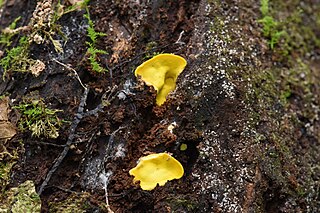
The Polyporales are an order of about 1800 species of fungi in the division Basidiomycota. The order includes some polypores as well as many corticioid fungi and a few agarics. Many species within the order are saprotrophic, most of them wood-rotters. Some genera, such as Ganoderma and Fomes, contain species that attack living tissues and then continue to degrade the wood of their dead hosts. Those of economic importance include several important pathogens of trees and a few species that cause damage by rotting structural timber. Some of the Polyporales are commercially cultivated and marketed for use as food items or in traditional Chinese medicine.

Junghuhnia is a genus of crust fungi in the family Steccherinaceae. It was circumscribed by Czech mycologist August Carl Joseph Corda in 1842. The generic name honours German-Dutch botanist Franz Wilhelm Junghuhn.

The Meruliaceae are a family of fungi in the order Polyporales. According to a 2008 estimate, the family contains 47 genera and 420 species. As of April 2018, Index Fungorum accepts 645 species in the family.

The Phanerochaetaceae are a family of mostly crust fungi in the order Polyporales.

Antrodiella is a genus of fungi in the family Steccherinaceae of the order Polyporales.

Flaviporus is a genus of poroid fungi in the family Steccherinaceae.

Irpex is a genus of corticioid fungi in the order Polyporales. Species produce fruit bodies that grow as a crust on the surface of dead hardwoods. The crust features an irpicioid spore-bearing surface, meaning it has irregular and flattened teeth. Irpex is distinguished from the similar genera Junghuhnia and Steccherinum by the simple septa found in the generative hyphae.

Mycorrhaphium is a genus of fungi in the family Steccherinaceae. The genus was circumscribed by Dutch mycologist Rudolph Arnold Maas Geesteranus in 1962. The type species is Mycorrhaphium adustum. Fruit bodies of species in the genus have caps, stipes, and a hydnoid (tooth-like) hymenophore. There is a dimitic hyphal system, where the skeletal hyphae are found only in the tissue of the "teeth", and a lack of cystidia. The spores are smooth, hyaline (translucent), and inamyloid.

Steccherinum is a widely distributed genus of toothed crust fungi in the family Steccherinaceae.

The hydnoid fungi are a group of fungi in the Basidiomycota with basidiocarps producing spores on pendant, tooth-like or spine-like projections. They are colloquially called tooth fungi. Originally such fungi were referred to the genus Hydnum, but it is now known that not all hydnoid species are closely related.

Fibroporia is a genus of ten species of poroid crust fungi in the family Fomitopsidaceae. The genus contains species similar to those in genus Antrodia, but they are phylogenetically distinct.
Antella is a genus of three species of crust fungi in the family Steccherinaceae.
Atraporiella is a monotypic fungal genus in the family Steccherinaceae. It contains the crust fungus Atraporiella neotropica, known only from Belize.
Trulla is a fungal genus in the family Steccherinaceae containing six species of polypores. It was circumscribed by mycologists Otto Miettinen and Leif Ryvarden in 2016, as a continuation of prior work that outlined a revised framework for the Steccherinaceae based on molecular phylogenetics. Its closest relative in the Steccherinaceae is the genus Nigroporus, from which it differs in its light-coloured fruit bodies and monomitic context.

Metuloidea is a genus of five species of fungi in the family Steccherinaceae. The genus was circumscribed by New Zealand-based mycologist Gordon Herriot Cunningham in 1965. The type species is M. tawa, a fungus originally described by Cunningham as a species of Trametes. Formerly classified in family Meruliaceae, Metuloidea was moved to the Steccherinaceae in 2016, following prior research that outlined a revised framework for the Steccherinaceae based on molecular phylogenetics.

Metuloidea murashkinskyi is a species of tooth fungus in the family Steccherinaceae. It is found in Europe and Asia, where it causes a white rot on the wood of deciduous trees.
Butyrea is a genus of two species of crust fungi in the family Steccherinaceae.
Metuloidea cinnamomea is a species of tooth fungus in the family Steccherinaceae. Found in the Andes region of Venezuela, it was initially described in 2010 by Teresa Iturriaga and Leif Ryvarden as a species of Antrodiella. Otto Miettinen and Ryvarden transferred it to the newly created genus Metuloidea in 2016.
Trulla dentipora is a neotropical polypore fungus in the family Steccherinaceae, and the type species of the genus Trulla. Characteristics of this species are the irregularly shaped pores with jagged or teeth-like edges, and the sausage-shaped spores. Found in Venezuela, the fungus was originally described by mycologists Leif Ryvarden and Teresa Iturriaga in 2004 as a species of Antrodiella. The type was collected in Henri Pittier National Park, where it was found growing on a hardwood log. Ryvarden and Otto Miettinen transferred the fungus to the newly created Trulla in 2016.
Antella niemelaei is a species of poroid crust fungus in the family Steccherinaceae.


















